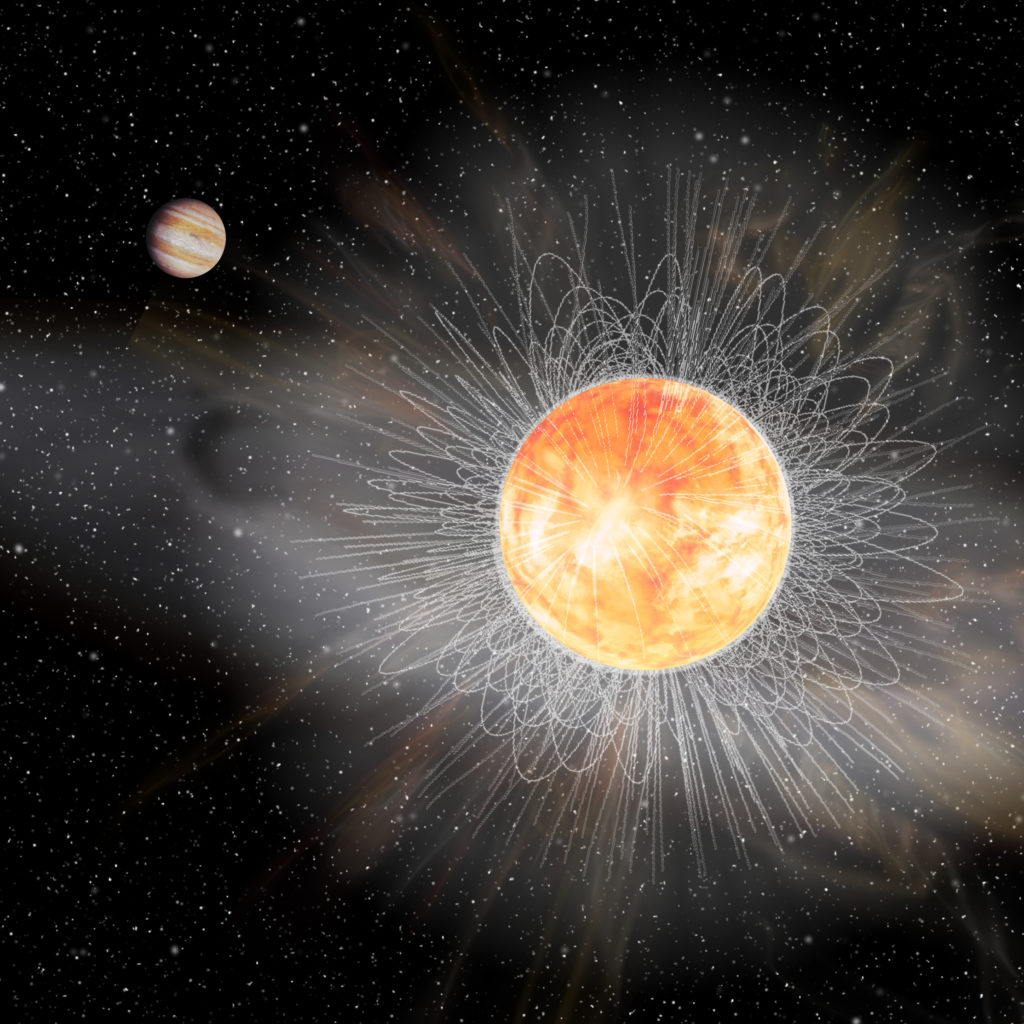The team of astronomers from the United States and Europe combined observations of 51 Pegasi from NASA’s Transiting Exoplanet Survey Satellite (TESS) with cutting-edge measurements of its magnetic field from the Large Binocular Telescope (LBT) in Arizona using the Potsdam Echelle Polarimetric and Spectroscopic Instrument (PEPSI). Although the exoplanet that orbits 51 Pegasi does not pass in front of its parent star as seen from Earth, the star itself shows subtle brightness variations in the TESS observations that can be used to measure the star’s radius, mass, and age – a technique known as asteroseismology. Meanwhile, the magnetic field of the star imprints a tiny amount of polarization on the starlight, allowing PEPSI on the LBT to create a magnetic map of the stellar surface as the star rotates – a technique known as Zeeman-Doppler Imaging. Together, these measurements allowed the team to evaluate the current magnetic environment around the star.
Previous observations from NASA’s Kepler space telescope already suggested that magnetic braking might weaken substantially beyond the age of the Sun, severing the close relationship between rotation and magnetism in older stars. However, the evidence for this change was indirect, relying on measurements of the rotation rate for stars with a wide range of ages. It was clear that rotation stopped slowing down somewhere near the age of the Sun (4.5 billion years), and that weakened magnetic braking in older stars could reproduce this behavior. However, only direct measurements of a star’s magnetic field can establish the underlying causes, and the targets observed by Kepler were too faint for LBT observations. The TESS mission began collecting measurements in 2018 – similar to Kepler’s observations but for the nearest and brightest stars in the sky, including 51 Pegasi.

Over the past few years, the team began using PEPSI on the LBT to measure the magnetic fields for several TESS targets, gradually building a new understanding of how magnetism changes in stars like the Sun as they grow older. The observations revealed that magnetic braking changes suddenly in stars that are slightly younger than the Sun, becoming more than 10 times weaker at that point, and diminishing further as the stars continue to age. The team attributed these changes to an unexpected shift in the strength and complexity of the magnetic field, and the influence of that shift on the stellar wind. The newly measured properties of 51 Pegasi show that – just like our own Sun – it has already gone through this transition to weakened magnetic braking.
“It is very gratifying that the LBT and PEPSI were able to reveal a new perspective on this planetary system which played such a pivotal role in exoplanet astronomy,” says Klaus Strassmeier, principal investigator of the PEPSI spectrograph. “This research is an important step forward in the search for life in our galaxy.”
In our own solar system, life’s transition from the oceans onto land occurred several hundred million years ago, coinciding with the time that magnetic braking began to weaken in the Sun. Young stars bombard their planets with radiation and charged particles that are hostile to the development of complex life, but older stars appear to provide a more stable environment. According to Metcalfe, the team’s findings suggest that the best places to look for life outside of our solar system might be around stars that are middle-aged and older.
Reference:
Weakened Magnetic Braking in the Exoplanet Host Star 51 Peg
Travis S. Metcalfe, Klaus G. Strassmeier, Ilya V. Ilyin, Derek Buzasi, Oleg Kochukhov, Thomas R. Ayres, Sarbani Basu, Ashley Chontos, Adam J. Finley, Victor See, Keivan G. Stassun, Jennifer L. van Saders, Aldo G. Sepulveda, and George R. Ricker
THE ASTROPHYSICAL JOURNAL LETTERS, Vol. 960, p. L6
https://iopscience.iop.org/article/10.3847/2041-8213/ad0a95
Contact:
Dr. Travis S. Metcalfe, White Dwarf Research Corporation, USA. E-mail: travis@wdrc.org
Prof. Dr. Klaus G. Strassmeier, AIP, Germany. E-Mail: kstrassmeier@aip.de

